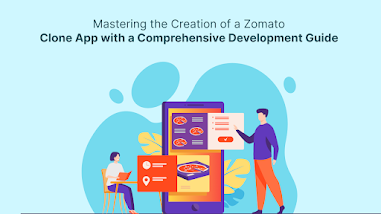In the rapidly growing food delivery market, creating a Zomato clone app can be a lucrative opportunity. With the right approach, you can develop a platform that rivals established giants while offering unique features to attract and retain users. This comprehensive development guide will walk you through the essential steps to master the creation of your own Zomato clone app.
Conducting Market Research
The first step in developing a Zomato clone app is thorough market research. This involves understanding the current trends in the food delivery industry, identifying your target audience, and analyzing your competitors.
- Analyze Industry Trends: Examine current trends, such as the increasing demand for contactless delivery and the integration of AI for personalized recommendations.
- Identify Target Audience: Determine who will use your app, including their preferences, dining habits, and location.
- Competitor Analysis: Study successful food delivery platforms to understand their strengths and weaknesses. Identify gaps in their offerings that your app can fill.
Defining Core Features
To ensure your Zomato clone app stands out, you need to incorporate essential features and functionalities. Here’s a breakdown of key features to consider:
- User Registration and Profiles: Allow users to create and manage accounts, including preferences and order history.
- Restaurant Listings: Provide a comprehensive list of restaurants with detailed menus, images, and reviews.
- Search and Filters: Implement search functionality and filters to help users find restaurants based on cuisine, location, and ratings.
- Order Placement and Tracking: Enable users to place orders and track them in real-time. Integration with GPS for live tracking is crucial.
- Payment Integration: Offer multiple payment options, including credit/debit cards, digital wallets, and cash on delivery.
- Ratings and Reviews: Allow users to rate and review restaurants and delivery experiences.
- Admin Dashboard: Develop an admin panel for managing restaurant listings, user accounts, and order analytics.
Designing the User Experience (UX)
A well-designed app is critical for user engagement and satisfaction. Focus on creating a user-friendly interface and a seamless experience:
- User Interface (UI): Design an intuitive and visually appealing interface. Ensure that navigation is straightforward and that key features are easily accessible.
- User Experience (UX): Optimize the app’s performance to provide a smooth and fast user experience. Consider aspects such as load times, ease of ordering, and the simplicity of tracking orders.
- Prototyping and Feedback: Develop prototypes and conduct user testing to gather feedback. Use this information to refine the design and improve usability.
Selecting the Technology Stack
Choosing the right technology stack is crucial for building a scalable and reliable app. Consider the following:
- Frontend Development: Use frameworks like React Native or Flutter for building a responsive and cross-platform app.
- Backend Development: Opt for robust backend technologies such as Node.js, Ruby on Rails, or Django to handle server-side operations.
- Database Management: Select a reliable database like MongoDB, MySQL, or PostgreSQL to manage user data, restaurant information, and order details.
- APIs: Integrate APIs for maps, payment gateways, and notifications to enhance functionality.
Development Process
With planning and design complete, you can begin the development phase. This involves coding both the frontend and backend of your app.
- Frontend Coding: Build the user interface based on your design, ensuring compatibility across different devices and platforms.
- Backend Coding: Develop server-side logic, including order management, payment processing, and data storage.
- Testing: Conduct comprehensive testing to identify and resolve bugs. Test for functionality, performance, and security to ensure a smooth user experience.
Launch and Marketing
After development, prepare for a successful launch:
- App Store Submission: Submit your app to major app stores, ensuring it meets their guidelines and requirements.
- Marketing Strategy: Implement a marketing plan to promote your app. Use digital marketing techniques such as social media campaigns, influencer partnerships, and online advertising.
- User Onboarding: Create engaging onboarding experiences to help new users and restaurant partners navigate the app effectively.
Post-Launch Support and Maintenance
Ongoing support and maintenance are vital for long-term success:
- Customer Support: Provide responsive customer support to address user and restaurant partner issues promptly.
- Regular Updates: Release updates to fix bugs, improve performance, and add new features based on user feedback.
- Performance Monitoring: Use analytics tools to monitor app performance and make data-driven improvements.
Conclusion
Mastering the creation of a Zomato clone app requires careful planning, design, and execution. By following this comprehensive development guide, you can build a competitive food delivery platform that meets user needs and stands out in the market. Focus on delivering a superior user experience, leveraging the right technology, and continuously evolving based on feedback to ensure your app's success.





No comments:
Post a Comment